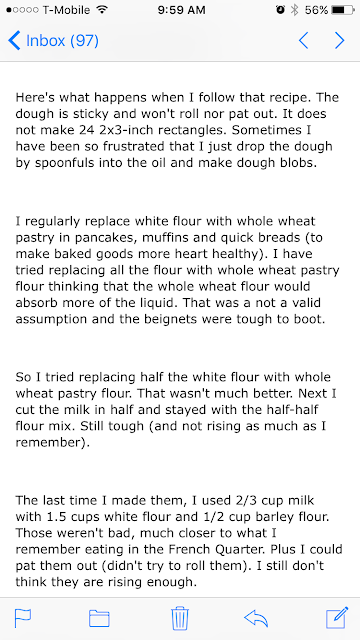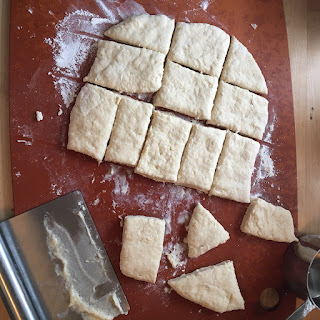Today's post comes as the result of a question about beignets, and brings with it some questions of its own. (If you have any insights into beignets, please read through all of this and respond with your suggestions.)
Let me start by saying that it has been a very long time since I have been to New Orleans. And I truly don't remember whether we actually had beignets at that time. So, in my head, I have always had a strange mash-up of New Orleans beignets and South American sopaipillas in my head when I think of them. (They're both fried dough, though the sopaipillas I seem to remember are supposed to be hollow so you can pour things like honey into them.)
I don't have any idea what the interior of a beignet is supposed to be like. Is it supposed to be open and full of air? Is it supposed to be like a doughnut - kind of full of dough, but also fluffy?
Not a clue.
So I kind of started this challenge the way the second round of each episode of The Great British (or American) Baking Show goes: recipe in hand, with some vague idea of what I should end up with.
But I get ahead of myself. Let me go back and start with the query that got me going. My friend CindyfromIdaho (because I've moved a few times as an adult, I tend to name people with metropolitan-area reference points - I have a large number of friends with "fromBaltimore" as part of their names - and Christopher eventually starts referring to them that way, too) sent me the follow recipe and questions:
 |
| Let's take a moment, here, and appreciate that these two images are screen captures from my phone. This is a huge (if slightly pathetic) technological step forward for me. |
So... reading through the recipe and commentary, I figured I'd start with the recipe pretty much "as-is" and see what happened. And here we go:
 |
| So far, this was seeming pretty normal. |
 |
| That's... kinda... liquid. |
Even so, giving the recipe the benefit of the doubt, I flopped it out onto a floured board and tried to work with it.
The things I do for (kitchen) science...
 |
| Note: For once I was smart and took off my wedding ring before digging in. I'm not sure that I'd ever have gotten it clean. |
 |
| Honestly. I tried to work it around - you can see how the flour got moved around when I was trying to knead it. |
I had entirely planned to work with the recipe as it was, but I didn't want to just drop dough globs into the oil, so I had to think of a back-up plan. I added flour. About a half cup, to be relatively precise. This resulted in a manageable dough that was kind of half a step off from what you look for when you're making biscuits.
 |
| No more glop in the bottom of the bowl. |
 |
| I didn't lose my fingers in it while I was kneading it. |
 |
| Sorry for the bad lighting. You'll have to trust me that it was as close to 1/3 inch as I could get it. |
 |
| Cutting this into 2"x3" rectangles was a bit of a challenge due to the shape, but I tried. |
Okay. Yeah. There's no way in the world that would have come out to 24. I got 15 - and that's counting the little triangular ones.
I feel I should mention, here, that we don't often deep-fry food in our house. A few days earlier, I made some cream cheese wontons for Christopher's birthday, and decided to keep the oil in the pan. This is why there is already "stuff" in the oil in the following photo.
If you're going to reuse frying oil, I'd recommend straining it out and putting it back into the bottle (if you can). Until the oil goes bad (you can tell by the smell - or if it goes cloudy) you can probably reuse it. (Though I'm sure someone with better kitchen science know-how would say I'm wrong.)
One HUGE caveat: You know how you can buy infused oils? Those are made by heating oil and putting something (such as herbs or spices) into it. This means that anything you fry will also leave some flavor behind. In other words: if you don't want your beignets to taste like cod, you're going to want different oil for making your fish and chips.
 | |||
| I should probably use a deep-frying thermometer, but instead I go with the "if the top is beginning to ripple, it's probably about right" theory. |
If you've done much frying, you know that most things sink to the bottom when you first put them in the oil, and then they rise as the air inside expands. (This is also what causes the light, airy interiors.)
You probably also know the theory that says that the first ones you fry almost never turn out as well as the next ones. So let's look at the next set of pictures, instead of dwelling on these.
I know there's a lot of pictures of things being fried, here. The reason I'm including all of them is because I think it's cool to see how the flat pieces of dough expanded as they cooked. They went from 1/3-inch thick to more like 2-inches thick from start to finish, as they browned away.
As I pulled each batch out of the pan (remembering to not crowd the pan, because it can lower the temperature too much), I did set them aside to cool and "drip dry" on paper towel, then eventually got around to plating them to eat.
I dusted them with powdered sugar, and then realized that since one of CindyfromIdaho's questions was about the amount of rise they'd gotten, I should crack one open.
This is when I realized that I have no idea what they're supposed to be like inside.
 |
| Does anyone know if this is too doughy? |
I'm not going to lie. Christopher and I kind of went to town on them. Totally for the sake of science, though, I swear. We came to the conclusion that the dough was a little tough, and not really sweet enough for our taste.
I'm guessing that the toughness was because of two things: a) I probably should have started by adding less flour and working my way up, because the extra flour may have been the problem; b) I may have over-kneaded them and worked up too much gluten (remember my comment about biscuits? I have a lot more experience with those...)
Oh, and to deal with the "not quite sweet enough" factor, I may have tossed the next batch into a bowl with more powdered sugar and shaken them up.
So, how do we feel about this at the end of the post? And how can we help CindyfromIdaho?
- The recipe is obviously flawed. The ingredient ratio is just off. Period. And the idea of getting the number of beignets they claim to get - at the size they say - is pretty much impossible.
- The toughness was probably my fault.
- I'm unsure about the rise - I think they turned out okay for me, but CindyfromIdaho says they don't seem to rise enough for her. Here's a question for anyone: I'm at about 800 ft above sea level, while she is at about 4,000 ft above sea level - and the recipe was probably written by people living about 10 ft above sea level. Could that be the problem - or at least part of it?
And - next week - we'll be re-heating the oil for a much simpler way to fry up some morning goodness.
*****
Do you have a recipe that you're unsure of? Is it not performing how you think it should? Do you want me to try it? Send it my way!















No comments:
Post a Comment